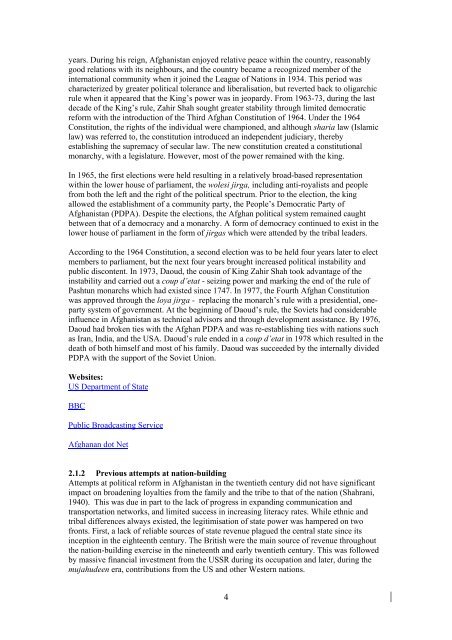Afghanistan. - Forced Migration Online
Afghanistan. - Forced Migration Online
Afghanistan. - Forced Migration Online
You also want an ePaper? Increase the reach of your titles
YUMPU automatically turns print PDFs into web optimized ePapers that Google loves.
years. During his reign, <strong>Afghanistan</strong> enjoyed relative peace within the country, reasonably<br />
good relations with its neighbours, and the country became a recognized member of the<br />
international community when it joined the League of Nations in 1934. This period was<br />
characterized by greater political tolerance and liberalisation, but reverted back to oligarchic<br />
rule when it appeared that the King’s power was in jeopardy. From 1963-73, during the last<br />
decade of the King’s rule, Zahir Shah sought greater stability through limited democratic<br />
reform with the introduction of the Third Afghan Constitution of 1964. Under the 1964<br />
Constitution, the rights of the individual were championed, and although sharia law (Islamic<br />
law) was referred to, the constitution introduced an independent judiciary, thereby<br />
establishing the supremacy of secular law. The new constitution created a constitutional<br />
monarchy, with a legislature. However, most of the power remained with the king.<br />
In 1965, the first elections were held resulting in a relatively broad-based representation<br />
within the lower house of parliament, the wolesi jirga, including anti-royalists and people<br />
from both the left and the right of the political spectrum. Prior to the election, the king<br />
allowed the establishment of a community party, the People’s Democratic Party of<br />
<strong>Afghanistan</strong> (PDPA). Despite the elections, the Afghan political system remained caught<br />
between that of a democracy and a monarchy. A form of democracy continued to exist in the<br />
lower house of parliament in the form of jirgas which were attended by the tribal leaders.<br />
According to the 1964 Constitution, a second election was to be held four years later to elect<br />
members to parliament, but the next four years brought increased political instability and<br />
public discontent. In 1973, Daoud, the cousin of King Zahir Shah took advantage of the<br />
instability and carried out a coup d’etat - seizing power and marking the end of the rule of<br />
Pashtun monarchs which had existed since 1747. In 1977, the Fourth Afghan Constitution<br />
was approved through the loya jirga - replacing the monarch’s rule with a presidential, oneparty<br />
system of government. At the beginning of Daoud’s rule, the Soviets had considerable<br />
influence in <strong>Afghanistan</strong> as technical advisors and through development assistance. By 1976,<br />
Daoud had broken ties with the Afghan PDPA and was re-establishing ties with nations such<br />
as Iran, India, and the USA. Daoud’s rule ended in a coup d’etat in 1978 which resulted in the<br />
death of both himself and most of his family. Daoud was succeeded by the internally divided<br />
PDPA with the support of the Soviet Union.<br />
Websites:<br />
US Department of State<br />
BBC<br />
Public Broadcasting Service<br />
Afghanan dot Net<br />
2.1.2 Previous attempts at nation-building<br />
Attempts at political reform in <strong>Afghanistan</strong> in the twentieth century did not have significant<br />
impact on broadening loyalties from the family and the tribe to that of the nation (Shahrani,<br />
1940). This was due in part to the lack of progress in expanding communication and<br />
transportation networks, and limited success in increasing literacy rates. While ethnic and<br />
tribal differences always existed, the legitimisation of state power was hampered on two<br />
fronts. First, a lack of reliable sources of state revenue plagued the central state since its<br />
inception in the eighteenth century. The British were the main source of revenue throughout<br />
the nation-building exercise in the nineteenth and early twentieth century. This was followed<br />
by massive financial investment from the USSR during its occupation and later, during the<br />
mujahudeen era, contributions from the US and other Western nations.<br />
4
















